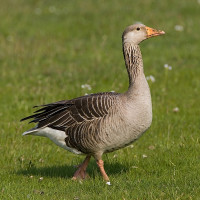Description
The lake is a protected natural area and managed favorable to biodiversity and birds. The area is mainly composed of open water, meadows, woods and hedges.
During the breeding season, a colony of herons (Grey Heron, Cattle Egret, Little Egret and Black-crowned Night Heron) settle in one of the willows bordering the lake. The raft and the islet in the center of the lake welcome a colony Black-headed Gull and Common Tern.
At the time of migration, various migrants are likely to be observed: Greylag Goose, Garganey, Ruff, Common Sandpiper, Dunlin, Whiskered Tern, Black Tern, Eurasian Spoonbill, Osprey and Sand Martin.
In winter, the site is frequented by many ducks including Mallard, Eurasian Wigeon and Common Teal. A large dormitory of gulls also forms every evening from November to February, it is composed of Lesser Black-backed Gull, European Herring Gull, Yellow-legged Gull and Black-headed Gull.
_________________________
Français: Le lac du Cébron, créé dans les années 80, est un site de halte migratoire et d'hivernage majeur pour les oiseaux dans le département des Deux-Sèvres. Le lac est un espace naturel sensible, géré par le Département des Deux-Sèvres. Il fait l'objet d'aménagements et d'une gestion favorable à la biodiversité et aux oiseaux. Il est compsé principalement d'eau libre, de prairies, de boisements et de haies.
En période de reproduction, une colonie d'ardéidés (Grey Heron, Cattle Egret,Little Egret et Black-crowned Night Heron)s'installent dans une des saulaies bordant le lac. Le radeau et l'îlot au centre du lac, accueillent une colonie de Black-headed Gull et de Common Tern.
Au moment des migrations, divers migrateurs sont suceptibles d'être observés : Greylag Goose, Garganey, Ruff, Common Sandpiper, Dunlin, Whiskered Tern, Black Tern, Eurasian Spoonbill, Osprey et Sand Martin.
En hiver, le site est féquenté par de nombreux anatidés dont le Mallard, le Eurasian Wigeon et la Common Teal. Un important dortoir de laridés se forme également tous les soirs de novembre à février, il est composé de Lesser Black-backed Gull, European Herring Gull, Yellow-legged Gull et de Black-headed Gull.
Details
Access
The site is accessible from the national road linking Parthenay to Thouars or the departmental road linking Saint-Loup-Lamairé to Gourgé. Just follow the signs "Lac du Cébron".
_________________________
Français: Le site est accessible depuis la route nationale reliant Parthenay à Thouars ou la route départementale reliant Saint-Loup-Lamairé à Gourgé. Il suffit de suivre les panneaux "Lac du Cébron".
Terrain and Habitat
Wetland , Lake , Beach , GrasslandConditions
FlatCircular trail
NoIs a telescope useful?
YesGood birding season
All year roundBest time to visit
Autumn migrationRoute
Paved road , Unpaved roadDifficulty walking trail
EasyAccessible by
Foot , Wheelchair , BicycleBirdwatching hide / platform
YesExtra info
English: Around the site, the hedged farmland is still relatively well preserved and several typical species such as, Wood Lark, and Red-backed Shrike can be easily observed.
_________________________
Français: Autour du site, le bocage est encore relativement bien conseré et plusieurs espèces typiques comme, l'Wood Lark, et la Red-backed Shrike peuvent être facilement observées.
